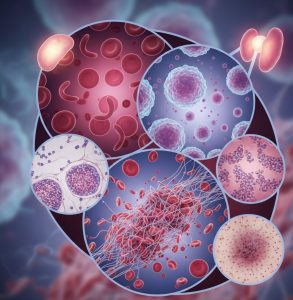Common Disorders Treated in Haematology

hematologic
Haematology, also spelled hematology, is a specialized field of medicine that delves into the intricate world of blood, blood-forming organs, and blood-related diseases. This area of study is essential because blood serves as the body’s lifeline, delivering oxygen and essential nutrients to cells while also removing waste products. When blood disorders arise, they can lead to serious health complications. In this article, we’ll explore some common disorders treated in haematology and the various approaches used to manage them effectively.
Anemia is one of the most widespread hematologic disorders affecting millions of people worldwide. It occurs when the body lacks a sufficient number of healthy red blood cells to transport adequate oxygen to tissues, which can result in a range of symptoms including fatigue, weakness, and sometimes shortness of breath. Anemia can significantly impact a person’s quality of life and, if left untreated, can lead to more severe health issues such as heart problems.
Anemia can result from a variety of factors, each affecting the body’s ability to produce or maintain healthy red blood cells:
- Iron deficiency: This is the most common cause of anemia and is often due to poor dietary intake or chronic blood loss, such as from heavy menstrual periods or gastrointestinal bleeding. Iron is crucial for hemoglobin production, and its deficiency can severely impair the body’s oxygen-carrying capacity.
- Vitamin deficiency: The lack of essential vitamins like B12 or folate can hinder red blood cell production. Vitamin B12 and folate are vital for the formation of DNA in red blood cells, and their deficiency can lead to megaloblastic anemia, characterized by the production of abnormally large and dysfunctional red blood cells.
- Chronic diseases: Conditions such as kidney disease or cancer can interfere with the body’s ability to produce red blood cells. In chronic kidney disease, for example, the hormone erythropoietin, which stimulates red blood cell production, is often deficient.
- Genetic conditions: Disorders like sickle cell anemia or thalassemia are inherited conditions that affect hemoglobin structure or production, leading to chronic anemia. These conditions often require specialized treatment strategies and regular monitoring.
The treatment of anemia is tailored to its type and underlying cause. For iron deficiency anemia, iron supplements or dietary changes can significantly improve iron levels and increase red blood cell production. Iron-rich foods include red meat, beans, and leafy green vegetables. Vitamin-deficiency anemia is typically managed with vitamin supplements, such as B12 injections or oral folate. In cases where anemia is caused by chronic diseases, managing the underlying condition is crucial. For severe cases, treatments may involve medications like erythropoiesis-stimulating agents, blood transfusions to quickly increase red blood cell count, or procedures to address the root cause. Each treatment plan is individualized, ensuring that patients receive the most effective care for their specific condition.
Leukemia is a serious type of cancer found in blood and bone marrow, marked by an overproduction of abnormal white blood cells. These cells can crowd out healthy blood cells, leading to a weakened immune system, anemia, and increased risk of bleeding. Leukemia can affect individuals of all ages, and its aggressive nature requires prompt diagnosis and treatment.
Leukemia is classified based on its progression speed and the specific type of white blood cells affected. The main types include:
- Acute lymphoblastic leukemia (ALL): This type progresses rapidly and is more common in children, though it can also affect adults. It involves the overproduction of immature lymphocytes, a type of white blood cell.
- Acute myeloid leukemia (AML): AML is characterized by the rapid growth of abnormal myeloid cells and is more prevalent in adults. It can quickly lead to severe symptoms if not treated promptly.
- Chronic lymphocytic leukemia (CLL): CLL progresses more slowly and often affects older adults. It involves the accumulation of small, mature lymphocytes that cannot function properly.
- Chronic myeloid leukemia (CML): This type also progresses slowly and is characterized by the overproduction of myeloid cells. It has a well-defined genetic marker known as the Philadelphia chromosome, which plays a role in its development.
The treatment for leukemia varies depending on the type and stage of the disease and may include a combination of therapies:
- Chemotherapy: This is the primary treatment for many types of leukemia and involves using powerful drugs to kill cancer cells or stop their growth. Chemotherapy can be administered orally or intravenously, and it often requires multiple cycles.
- Radiation therapy: High-energy rays are used to target and kill cancer cells, often employed when leukemia has spread to areas such as the brain or to shrink enlarged organs.
- Bone marrow transplant: Also known as a stem cell transplant, this procedure involves replacing diseased bone marrow with healthy marrow from a donor. It is a potentially curative approach for some patients, especially those with a compatible donor.
- Targeted therapy: This involves drugs that specifically target abnormalities in cancer cells, such as the BCR-ABL protein in CML. These therapies are less likely to affect normal cells and often have fewer side effects than traditional chemotherapy.
Lymphoma is a group of blood cancers that develop in the lymphatic system, a critical part of the body’s immune defense. The two main types of lymphoma are Hodgkin lymphoma and non-Hodgkin lymphoma, each with distinct characteristics and treatment approaches. Lymphoma can affect lymph nodes, spleen, thymus, and other parts of the body, leading to a variety of symptoms.
Common symptoms of lymphoma can vary but typically include:
- Swollen lymph nodes: Often painless, these can appear in the neck, armpits, or groin and may be the first noticeable sign of lymphoma.
- Fever: Persistent or recurrent fevers without an apparent cause can indicate an underlying issue such as lymphoma.
- Night sweats: These are intense enough to soak clothing and sheets and are a common symptom of lymphoma.
- Weight loss: Unexplained weight loss, often accompanied by loss of appetite, can be a sign of lymphoma.
- Fatigue: A persistent feeling of tiredness that does not improve with rest may occur due to the body’s ongoing immune response.
Treatment strategies for lymphoma depend on the type and stage of the disease and may involve:
- Chemotherapy: This remains a cornerstone treatment for many types of lymphoma, aimed at killing fast-growing cancer cells. It is often used in combination with other treatments.
- Radiation therapy: Used to target specific areas where lymphoma is present, radiation can be effective in shrinking tumors and alleviating symptoms.
- Immunotherapy: This approach harnesses the body’s immune system to fight cancer, using drugs like monoclonal antibodies that specifically target cancer cells.
- Stem cell transplant: Employed in certain cases, especially for relapsed or refractory lymphoma, this procedure allows for higher doses of chemotherapy by replacing damaged bone marrow with healthy cells.
Myeloma, also known as multiple myeloma, is a cancer of plasma cells, a type of white blood cell responsible for producing antibodies. In myeloma, cancerous plasma cells accumulate in the bone marrow, leading to bone damage and impairing blood cell production. This condition can cause a range of symptoms and complications that require comprehensive management.
Symptoms of myeloma can vary widely but often include:
- Bone pain: This is the most common symptom, often affecting the back or ribs, and can result from bone lesions or fractures.
- Frequent infections: Due to compromised immune function, individuals with myeloma are more susceptible to infections.
- Anemia: A decrease in red blood cell production can lead to symptoms like fatigue and weakness.
- High calcium levels: Also known as hypercalcemia, this can cause symptoms like increased thirst, frequent urination, constipation, and confusion.
- Kidney dysfunction: Myeloma proteins can damage the kidneys, leading to impaired function and symptoms like swelling and fatigue.
The treatment for myeloma is multifaceted and typically includes:
- Chemotherapy and targeted therapy: These are used to kill or slow the growth of myeloma cells and may include drugs like bortezomib or lenalidomide.
- Stem cell transplant: High-dose chemotherapy followed by a stem cell transplant can be an effective treatment for eligible patients, aiming for long-term remission.
- Bisphosphonates: These drugs help strengthen bones and reduce bone pain, an important aspect of managing myeloma-related bone disease.
- Corticosteroids: Used to reduce inflammation and manage symptoms, corticosteroids can also enhance the effectiveness of chemotherapy.
Hemophilia is a genetic disorder where blood doesn’t clot properly due to the lack of certain clotting factors. This can lead to excessive bleeding from even minor injuries, posing significant health risks if not managed properly. Hemophilia primarily affects males and is often diagnosed in early childhood.
The two main types of hemophilia are:
- Hemophilia A: This type is caused by a deficiency in factor VIII and is more common than hemophilia B. It can range from mild to severe, depending on the level of clotting factor present.
- Hemophilia B: Also known as Christmas disease, this type results from a deficiency in factor IX. It is less common and may also vary in severity.
Treatment for hemophilia focuses on replacing the missing clotting factors to prevent or control bleeding episodes:
- Replacement therapy: This involves infusing the missing clotting factors, either on a regular schedule (prophylaxis) or as needed during bleeding episodes. Advances in treatment have led to longer-lasting factor concentrates that require less frequent infusions.
- Desmopressin: A synthetic hormone used in mild cases of hemophilia A to stimulate the release of stored factor VIII from blood vessels.
- Antifibrinolytic medicines: These help prevent clots from breaking down, providing additional support in managing bleeding, especially during surgical procedures or dental work.
Thrombocytopenia is a condition characterized by an abnormally low number of platelets, which are necessary for blood clotting. This can lead to easy or excessive bruising and bleeding, affecting a person’s ability to heal from injuries and increasing the risk of serious bleeding complications.
Several factors can contribute to thrombocytopenia, including:
- Immune system disorders: Conditions like immune thrombocytopenic purpura (ITP) involve the immune system mistakenly attacking and destroying platelets.
- Medications: Certain drugs, such as chemotherapy agents or antibiotics, can reduce platelet production or lifespan.
- Infections: Viral infections like hepatitis C or HIV can affect platelet counts.
- Bone marrow disorders: Diseases like leukemia or aplastic anemia can impair platelet production, leading to thrombocytopenia.
Treatment for thrombocytopenia depends on the underlying cause and the severity of the condition. Options may include:
- Medications: Drugs like corticosteroids can help increase platelet production or suppress the immune system. In some cases, immunoglobulin infusions or thrombopoietin receptor agonists may be used to boost platelet counts.
- Blood or platelet transfusions: These are used in severe cases to quickly increase platelet levels and prevent bleeding complications.
- Treatment of underlying conditions: Addressing the root cause, such as changing medications or treating infections, is crucial in managing thrombocytopenia effectively.
Haematology covers a wide range of disorders, from anemia to complex cancers like leukemia and lymphoma. Understanding these conditions is crucial for timely diagnosis and effective treatment. If you or a loved one is experiencing symptoms related to these disorders, consulting a haematologist can be a critical step towards managing your health. Early intervention and proper management can significantly improve outcomes and quality of life for individuals with blood disorders.
By staying informed about the common disorders treated in haematology, patients and caregivers can better navigate the challenges these conditions present and seek appropriate medical care. Knowledge empowers patients to advocate for themselves and engage in discussions with healthcare providers, ensuring they receive the best possible care tailored to their unique needs. As research in haematology continues to advance, new treatments and therapies are emerging, offering hope for better management and outcomes for those affected by blood disorders.




